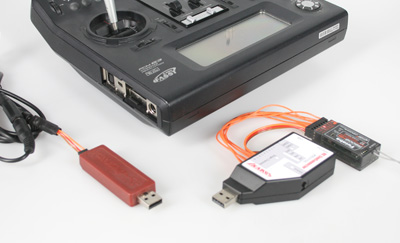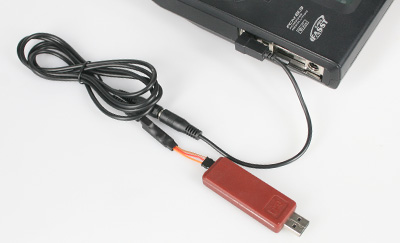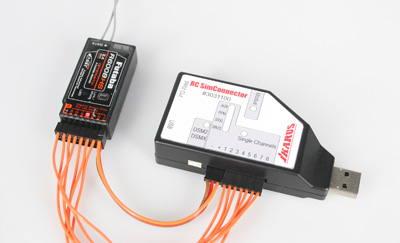Flying with a Futaba on the aeroflyRC
You have 2 different possibilities to connect a Futaba radio to the aeroflyRC.
You can use the trainer plug for a wired connection to the PC or you can use one of your Fuataba receiver for wireless flying.
Option #1: Flying via the trainer plug
 With the interface set #3031035 you can connect your Futaba radio to the aerofly via the 6 pin square trainer plug.
With the interface set #3031035 you can connect your Futaba radio to the aerofly via the 6 pin square trainer plug.
The advantages of this solution are:
- The HF module is off. You`ll fly directly via the trainer plug.
- You can use up to 12 channels for many special functions.
- The transmitter switches on automatically in trainer mode when you plug in the adapter.
- The set includes the USB interface and all required adapters.
- You only have to activate the trainer mode in the Futaba system menu.
Option #2: Flying wireless with a Futaba receiver

You can connect any 2.4 GHz receiver with at least 4 channels to the IKARUS RC SimConnector in the “Single Channel Mode”. Also one of your Futaba receivers. This solution transmits between 4 and max. 8 channels.
With 4 channels you can already fly throttle, elevator, rudder, aileron and all powered models, gliders, jets, helicopters and drones.
Optionally, you can also operate your Futaba receiver in S.Bus mode and then transmit all channels provided by the receiver to the RC SimConnector via a single patch cable.
Basic settings on the Futaba radio
Your Futaba radio offers many options for programming a RC model. In order to fly with a Futaba on the aeroflyRC a memory only with few basic settings is recommended. Below we describe a solution for a successful start with aeroflyRC.
- Bind the receiver to the sender.
- Open the Futaba menu and create a new model memory.
- Assign a name such as “aeroflyRC”.
- Select as model type a simple powered model, even if you want to fly gliders or helicopters on the aeroflyRC. Leave any selection for Delta and V-tail mixers “off”.
- If you want to control more functions such as landing gear and flaps via the radio, you can also setup additional encoders. The assignment to the functions will be done later in the aeroflyRC.
With this basic setting you can now continue with the calibration in aeroflyRC.
Launch the aeroflyRC and click in the main menu under “Controller” on “Search for a new controller”. Afterwards you should get the interface and the detected channel number reported and follow the further instructions for calibration. If you have any issues, please follow this interface test.
You will then find all details on the professional setting menu in the aeroflyRC manuals.



